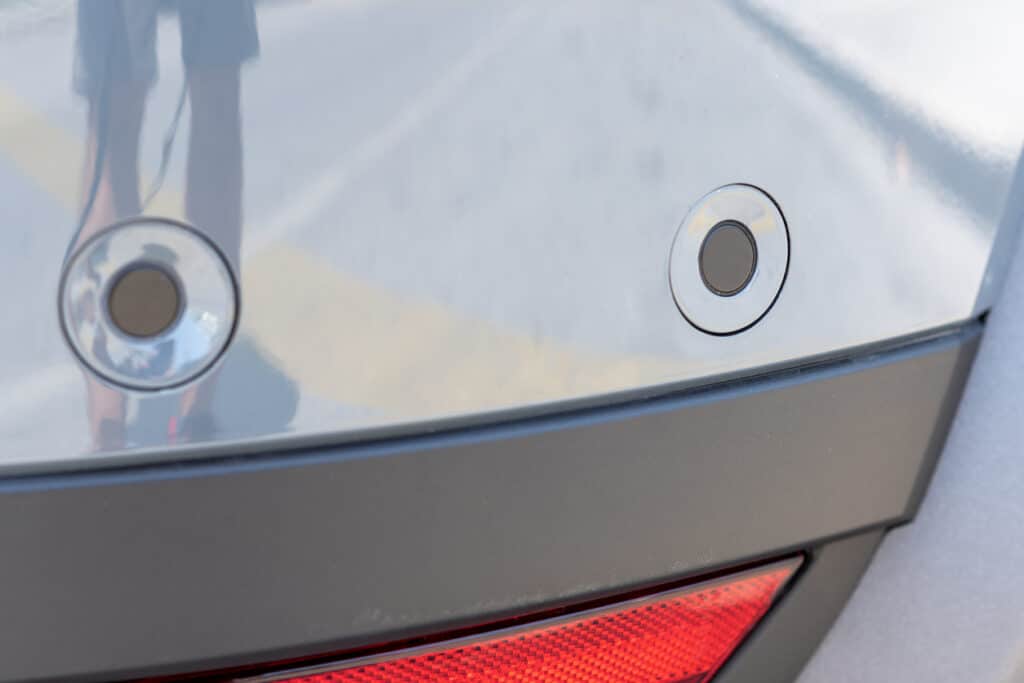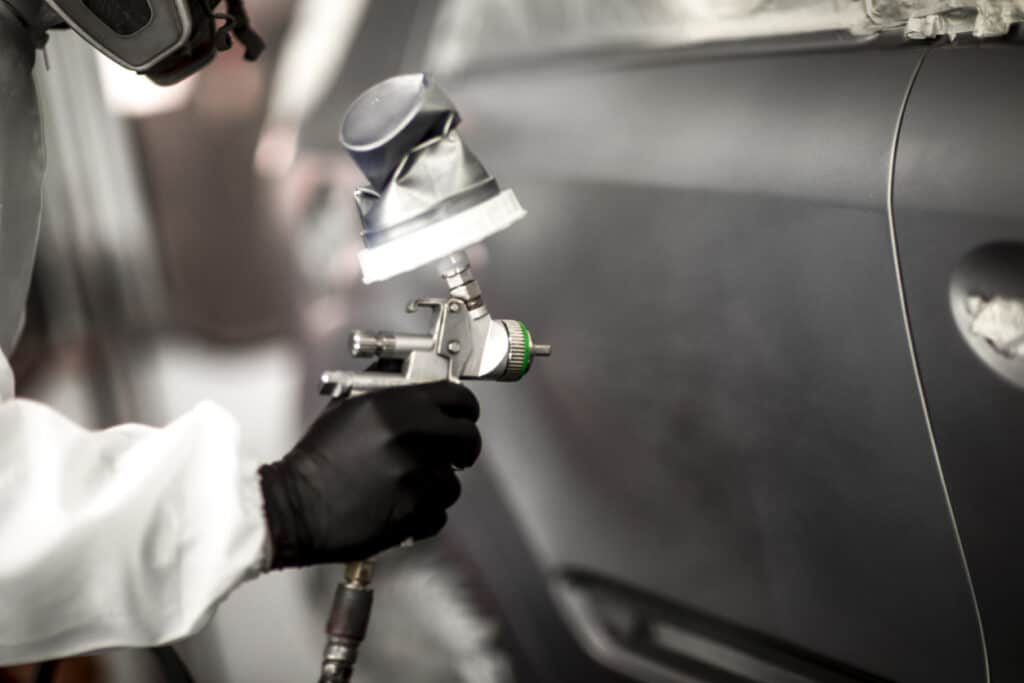Cars with Parking Sensors: Masking, Painting & Wrapping
Whether a customer wants a new paint job or they’re requesting a full body wrap, parking sensors can throw a spanner in the works and leave you scratching your head wondering how to tackle the job without hindering the effectiveness of the technology. Many parking sensors come in basic colours like black and silver, which can be less than ideal when your clients want to switch to more unique colours.
Regardless of whether the parking sensors are the more modern ultrasonic version that works by measuring how long it takes for a signal to bounce off an obstacle or the less common electromagnetic version that detects the presence of an object over time and alerts the driver accordingly, they can often puzzle professionals who’ve been tasked with covering them using paint or vinyl wrap.
And with parking sensors becoming a standard feature for many makes and models, it’s important that professionals in the body shop industry understand what’s possible and what’s not. Can parking sensors be wrapped or painted? How can you avoid overspray when painting the sensors? We have all the answers to your common questions right here to help you deal with parking sensors properly.
Can You Paint Parking Sensors?
In theory, applying automotive paint over parking sensors seems simple. However, it’s important to think about how the entire process can impact the effectiveness of the sensors. From sanding the surface to adding paint layers, the last thing you want to do is risk reducing the sensitivity or damaging the sensors beyond usability.

The first thing to note is that it’s generally safe to paint parking sensors as long as you’re careful with the technique. Thin paint layers will have the least impact on the effectiveness of most sensors, while you’ll also need to check that no dirt, debris, bubbles or dust appear on the surface since these can also be detected as obstacles in some cases.
Secondly, if the sensor has already been painted over, it’s not advisable to paint over it again. The additional layers can prevent the sensor from detecting obstacles as it should because they block the electromagnetic or ultrasonic waves from working. For older sensors using electromagnetic waves, additional paint can trigger the sensor constantly since it’ll detect an obstacle for a long period. This can be frustrating for customers and leave them dissatisfied with the job if they weren’t warned that this was a possibility. Luckily, it’s an easy process to mask off parking sensors and protect their functionality for your customers.
How to Mask Parking Sensors to Avoid Overspray
If your customer has requested that you don’t paint their sensors, it’s vital to understand the best masking technique for this job. Below we’ll guide you through the simple step-by-step instructions for using our JTAPE Parking Sensor Masking Discs.
The first step is to fold the easy lifting tab so that it sits upwards. This tab can be used to easily remove the disc from the film backing before pushing it back on itself to flatten it again. The disc can then be applied to the sensor and surrounding rubber seal, being careful to ensure that there are no gaps or bubbles underneath. Apply pressure across the disc to secure it on the surface of the sensor before beginning your paint application.
We recommend removing the discs while the clear coat is still wet. To do this, pull the easy lifting tab away from the sensor. This should leave you with a clean, residue-free removal.
How to Paint Parking Sensors
If your client has their heart set on a full paint job that covers the parking sensors, here’s the best method to follow:

1. Remove & clean the sensors
Whether the sensors are already fitted, or you’ve been tasked with replacing the technology, the first step is to ensure the sensor is removed from the car. This is because their small size can make them tricky to paint without pesky overspray impacting the overall finish.
For most vehicle types, this will involve removing the panel where the sensor sits, popping the cap off the sensor and unclipping the wires from the inside of the panel and the sensor. If the sensors are yet to be fitted, all you’ll need to do is remove the sensor cap ready for painting.
It’s equally as important to begin with clean sensors. Any dirt or debris left on the surface can have a huge impact on functionality if left under the paint surface. Specialist paint preparation wipes should do the trick, but you should double-check that the surface is completely dry and clean before moving on to the next steps.
2. Apply a plastic primer
Because most parking sensors are plastic, it’s vital to apply a coat of good-quality plastic primer. This will ensure the paint applies evenly across the surface and prevent flaking or chipping later down the line. Allow the primer to dry fully after application before applying the automotive paint. If the primer isn’t fully dry, you risk creating pockets of air on the sensor which can lead to an uneven finish.
3. Apply automotive paint
The best practice here is to apply as few coats of automotive paint as possible using thin, light layers. Aim for no more than three coats of automotive paint since this will give it the best chance of not affecting the functionality of the sensor. Again, check that each layer is completely dry before adding another, being careful to smooth out any lumps or bubbles.
4. Seal in the paint layers with a clear coat
A clear coat can also help prevent dirt and debris from affecting the surface of the sensor and hindering the technology from functioning as it should. Add a thin layer of clear coat paint to seal in your work and give it the best possible finish.
Can you wrap over parking sensors?
It’s typically recommended not to wrap over parking sensors because some can detect the wrap and be triggered each time the customer puts their car into reverse. The wrap can cause the ultrasonic or electromagnetic waves to bounce back quickly since it sits on the surface of the sensor. In some cases, it can even prevent the technology from working at all. Additional issues can arise if the wrap isn’t applied correctly. Gaps or air bubbles in the automotive wrap can leave the customer with sensors that aren’t as effective and are triggered at the wrong times. Ultimately, this can lead to unhappy customers who can no longer rely on the parking assist technology as a result of your application.
With extremely careful technique and a good quality vinyl wrap, a professional might be able to wrap over the parking sensors without hindering their effectiveness. However, with slight variations in different sensor types and how they detect obstacles, the best course of action is to steer your client away from wrapping. Be sure to inform them of the risks during a consultation so that they fully understand how wrapping can affect the sensors. If they still want to proceed with wrapping, it’s worth finding out if the sensitivity of the sensors can be adjusted since this can improve their functionality after application.
Each client’s needs are unique when it comes to their vehicle. So whether you’re advising them on the best ways to match the parking sensors to the rest of the vehicle or discussing the risks of masking over the sensors, we hope this piece gives you the knowledge and confidence you need.
At JTAPE, we’re proud to be a leading manufacturer and distributor of excellent-quality automotive masking products. To discover our full range, check out our product page.


